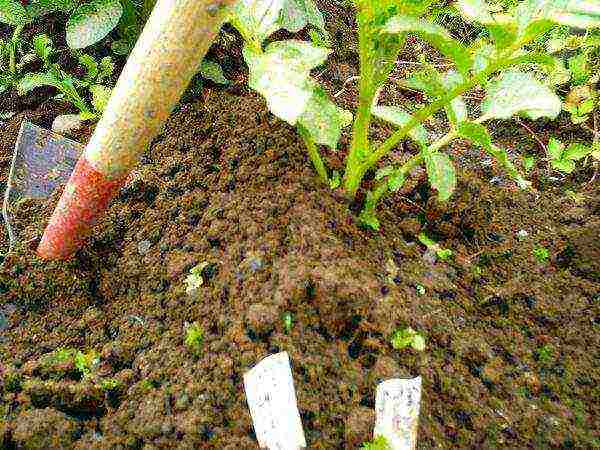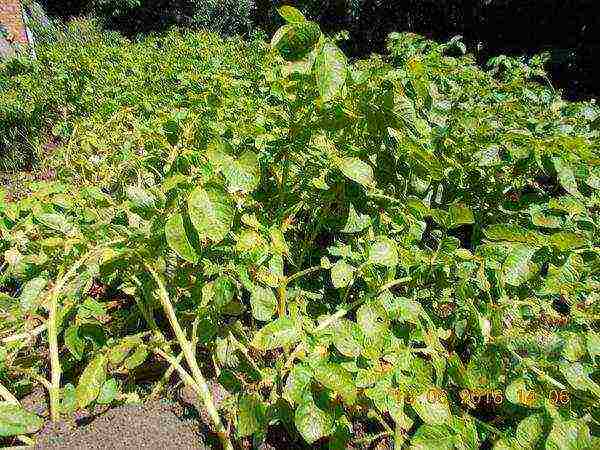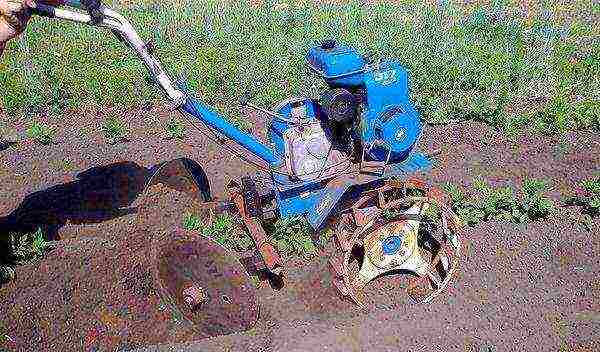Content
A lot of time has passed since the time when Tsar Peter 1 sent the first sack of potatoes from Holland to Russia and ordered to cultivate them throughout the country. And during this time, people, cultivating this culture, learned the features of this plant, and learned many "tricks" of potato cultivation, including hilling.
Practically the main "trick" is correct hilling. This process is one of the most important conditions to achieve the best and healthiest harvest possible.
Hilling is a damp earth sprinkling on the bottom of the plant, and is an environmentally friendly replacement for herbicides. Why and in what time frame to carry out this procedure and what purposes it should be described below.
- Gently sprinkling the lower part of the plant with soil, we we prevent the growth of weeds on potato plantings. And the emerging weeds will be much easier to pull out from loose soil than from hard and caked earth.
- This process loosens the soil, which means the roots of the plant will be more accessible to moisture and air. Loose soil is very important, since when watering, moisture will freely reach the roots, and during rains, water will not linger, and tubers will not rot.
- After the hilling process, there will be easier to harvest, which is required when digging potatoes from the ground. Accordingly, the number of tubers damaged during digging will be an order of magnitude less. It also reduces the chance of breakage of the tools used for hilling.
- Young plants become more resistant to winds and spring frosts... The "mound" of soil around the plant works like a thermos and does not let the frost penetrate deep into the soil. Also, this "mound" is supported by the potato plant itself, which has not yet fully formed and matured.
- The bush of the plant, after sprinkling its lower part with soil, begins to grow and branch intensively, forming more good and high-quality tubers in their roots.

The better a plant's bushes grow, the more leaves grow on them. The more leaves the plant contains, the more sunlight falls on them. As a result of this process, photosynthesis is more intense.
When and how many times you need to huddle a potato bed
Potato beds are best cultivated in the evening or early in the morningwhen there is no scorching sun. But this must be done on wet soil.
The first time the plant needs to be spud when it has grown more than 5 centimeters... The procedure will help to preserve it at an early stage from the effects of external factors.
There is a planting method in which hilling is carried out immediately after planting, raking a small hill over the planted potatoes. The method is used mainly in those regions where the probability of spring frosts is greater than in the middle lane.

The next time the potatoes are usually hilled after about two weeks, and when the bush has reached a height more than 15-20 centimeters... You need to try to do it before the first inflorescences appear on the potato.
If the bushes begin to stretch very strongly and fall in different directions, then it is necessary unplanned hilling... This will help keep the plant from falling and breaking the stem.The same should be done if, for some reason, sunlight falls on the tubers.
If there is no rain for a long time, and it's time to huddle, be sure to moisten the soil with water.

In what cases hilling is not required
- In hot regions, with low humidity and lack of watering, as in dry soil, the plant may die.
- When the plant is grown under the non-woven fabric in blackbut. But you need to make sure that the material does not transmit light to 100%. Otherwise, the potatoes will turn green and become completely inedible.
- When the method of growing potatoes is that the stalks of the potatoes are laid out on the ground and covered with soil, while leaving only the very tops. When the bushes grow again, the procedure is repeated again. Instead of soil, straw or cut grass is sometimes used. This growing method requires a lot more land per plant bush than the conventional method.

Correct hilling with a hoe by hand
The manual method involves the use of an auxiliary tool, such as a hoe. There are two techniques for this procedure:
- raking the soil around the bush towards the center of the plant
- soil is poured into the center of the bush, while the branches of the plant are bred a little to the sides.
The soil ridge as a result of hilling should turn out to be high about 15-20 centimeters.
Potato roots grow in different directions 30-40 centimeters... Consider this when hilling so as not to injure the tubers of the plant.
Using the manual tiller
The device serves to facilitate physical labor, when cultivating potatoes, and to save time. It consists of handle, handle and two discspointing towards the ground at an angle of 45 degrees. Using it is also not difficult.
You just need to pull the handle forward, guiding it along the boundary along the garden bed. A manual tiller can be bought in a store, or you can design it yourself.

Using a walk-behind tractor
If the plantings of potatoes are large, then you cannot do without a walk-behind tractor in your farm. He can not only loosen the soil and huddle, but also harvest potatoes. But the walk-behind tractor also has a minus. When harvesting, it can damage some of the tubers.
In the case when a walk-behind tractor with a plow-shaped hiller is used, you need adjust angle and depthon which the plow will sink. When using a walk-behind tractor with a disc tiller, you need to adjust the required distance between the discs and their angle of inclination.
The distance depends on the type of potato and is approximately from 40 to 70 centimeters... And the angle of adjustment of the disks should be the same for both disks, and is approximately 45 degrees.
There are also rippers on the disc walk-behind tractor. They prepare the soil in front of the block, which the disc hiller will in turn use to cover the potato bushes.

Before planting potatoes, you need to take into account that the walk-behind tractor will spud and harvest. Therefore, the beds should be even, and the distance between them should be such, so that the walk-behind tractor passes unhindered.
Regardless of how the process of hilling potatoes takes place, manually or with the help of various devices, the results are visible literally after one or two weeks. Bushes grow stronger, and tubers under the ground become larger and healthier.


